Optimal Design of Step-Sloping Notches for Cogging Torque Minimization of Single-Phase BLDC Motors
Abstract
:1. Introduction
2. Characteristic of a Single-Phase BLDC Motor
3. Specification of Single-Phase BLDC Motor and Reduction Method of Cogging Torque
4. Cogging Torque Reduction Method Using Step-Sloping Notches
4.1. Optimization of the Step-Sloping Notch Geometry to Minimize the Cogging Torque
4.2. OA Level Settings for DOE
4.3. Design Variables and Objective Functions
| - Design variables | ||||
| · 2° | ≤ | X1 (Notch (a) Angle) | ≤ | 20° |
| · 0.5 mm | ≤ | X2 (Notch (a) Size) | ≤ | 3 mm |
| · 2° | ≤ | X3 (Notch (b) Angle) | ≤ | 20° |
| · 0.5 mm | ≤ | X4 (Notch (b) Size) | ≤ | 3 mm |
| · −10° | ≤ | X5 (Notch (a) Sloping Angle) | ≤ | 10° |
| · −10° | ≤ | X6 (Notch (b) Sloping Angle) | ≤ | 10° |
| · 1 | ≤ | X7 (Layer of Stek) | ≤ | 15 |
- −
- Objective functionReduce the cogging torque
- −
- Constraint’s conditionEfficiency ≥ 70%Torque ≥ 390 mN·m
5. Optimal Design Results
6. Conclusions
Author Contributions
Funding
Institutional Review Board Statement
Informed Consent Statement
Data Availability Statement
Acknowledgments
Conflicts of Interest
References
- Rahman, M.A.; Little, T.A. Dynamic performance analysis of permanent magnet synchronous motors. IEEE Trans. Power Appar. Syst. 1984, PAS-103, 1277–1282. [Google Scholar] [CrossRef]
- Fazil, M.; Rajagopal, K.R. A novel air-gap profile of single-phase permanent-magnet brushless dc motor for starting torque improvement and cogging torque reduction. IEEE Trans. Magn. 2010, 46, 3928–3932. [Google Scholar] [CrossRef]
- Chung, D.W.; You, Y.M. Cogging torque reduction in permanent-magnet brushless generators for small wind turbines. J. Magn. 2015, 20, 176–185. [Google Scholar] [CrossRef] [Green Version]
- Bentouati, S.; Zhu, Z.Q.; Howe, D. Influence of design parameters on the starting torque of a single-phase PM brushless DC motor. IEEE Trans. Magn. 2000, 36, 3533–3536. [Google Scholar] [CrossRef] [Green Version]
- Kang, G.H.; Son, Y.D.; Kim, G.T.; Hur, J. A novel cogging torque reduction method for interior-type permanent-magnet motor. IEEE Trans. Ind. Appl. 2009, 45, 161–167. [Google Scholar] [CrossRef]
- Schlensok, C.; Gracia, M.H.; Hameyer, K. Combined numerical and analytical method for geometry optimization of a PM motor. IEEE Trans. Magn. 2006, 42, 1211–1214. [Google Scholar] [CrossRef]
- Park, Y.U.; Cho, J.H.; Kim, D.K. Cogging torque reduction of single-phase brushless DC motor with a tapered air-gap using optimizing notch size and position. IEEE Trans. Ind. Appl. 2015, 51, 4455–4463. [Google Scholar] [CrossRef]
- Park, Y.U.; So, J.Y.; Woo, K.I.; Kim, D.K. Cogging Torque Reduction Method of a Single-Phase BLDC Motor using Asymmetric Sloping Notch. Trans. Korean Inst. Electr. Eng. 2017, 66, 1569–1574. [Google Scholar]
- Park, Y.U.; So, J.Y.; Chung, D.H.; Yoo, Y.M.; Cho, J.H.; Ahn, K.S.; Kim, D.K. Optimal design of stator shape for cogging torque reduction of single-phase BLDC motor. Trans. Korean Inst. Electr. Eng. 2013, 62, 1528–1534. [Google Scholar] [CrossRef] [Green Version]


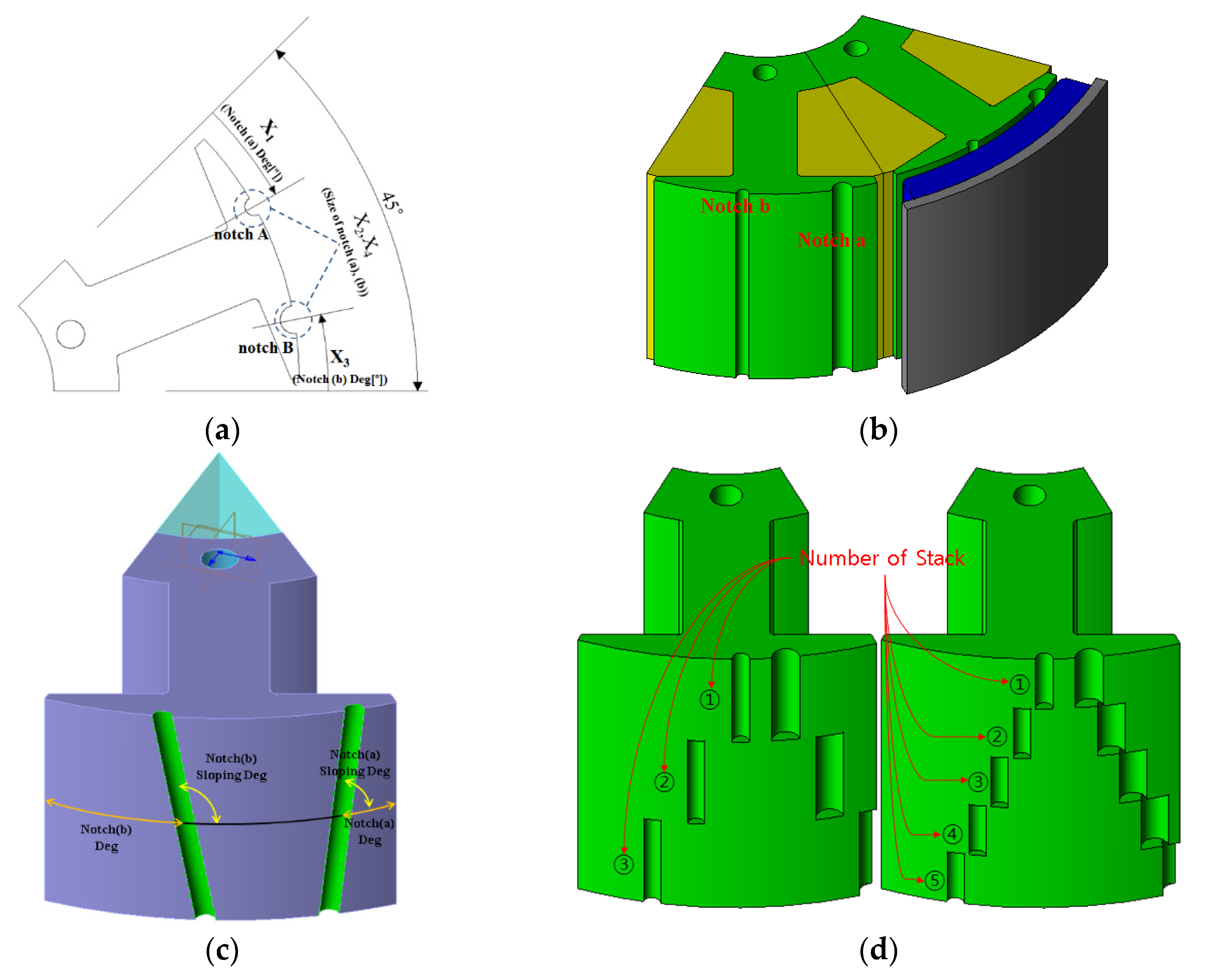

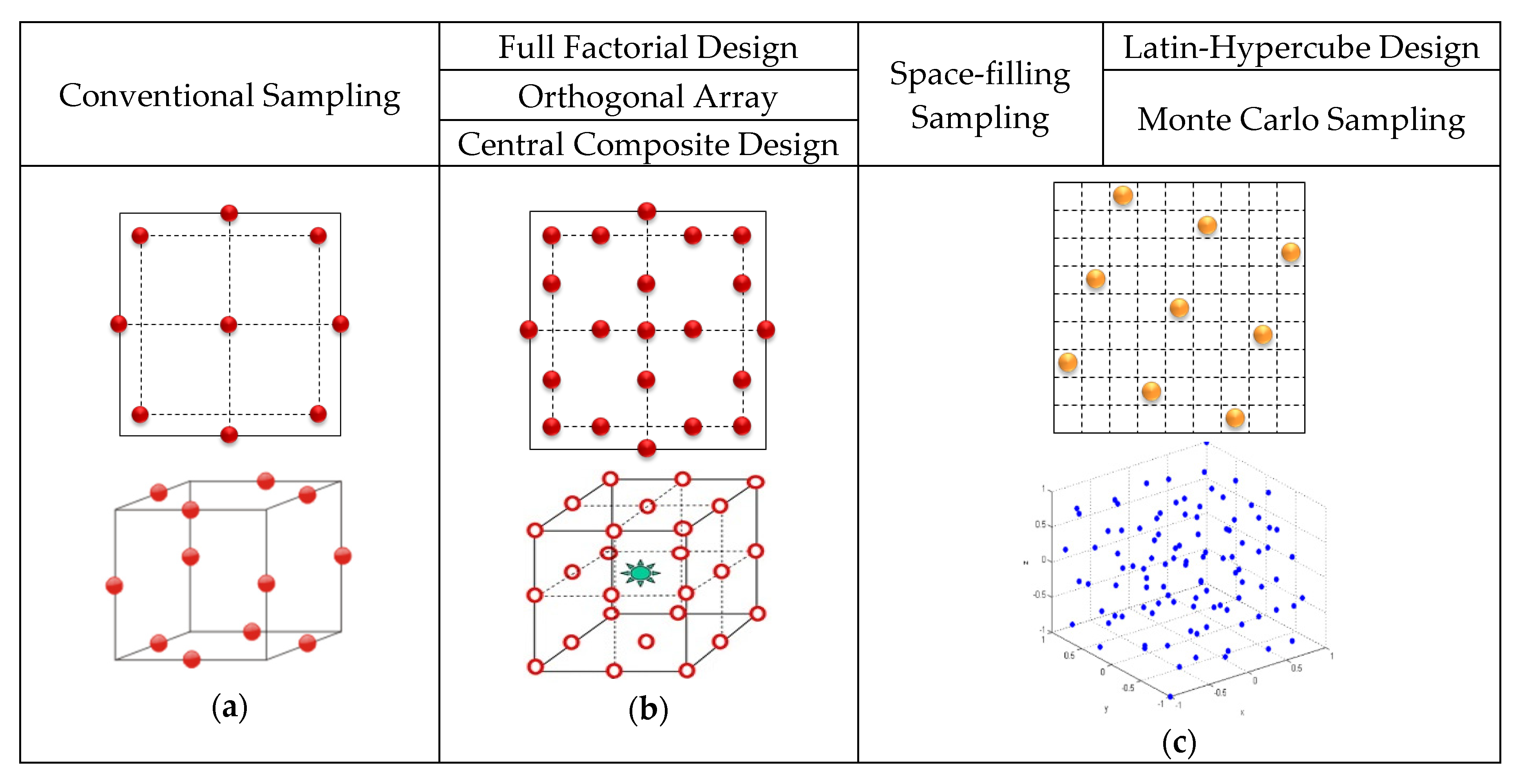

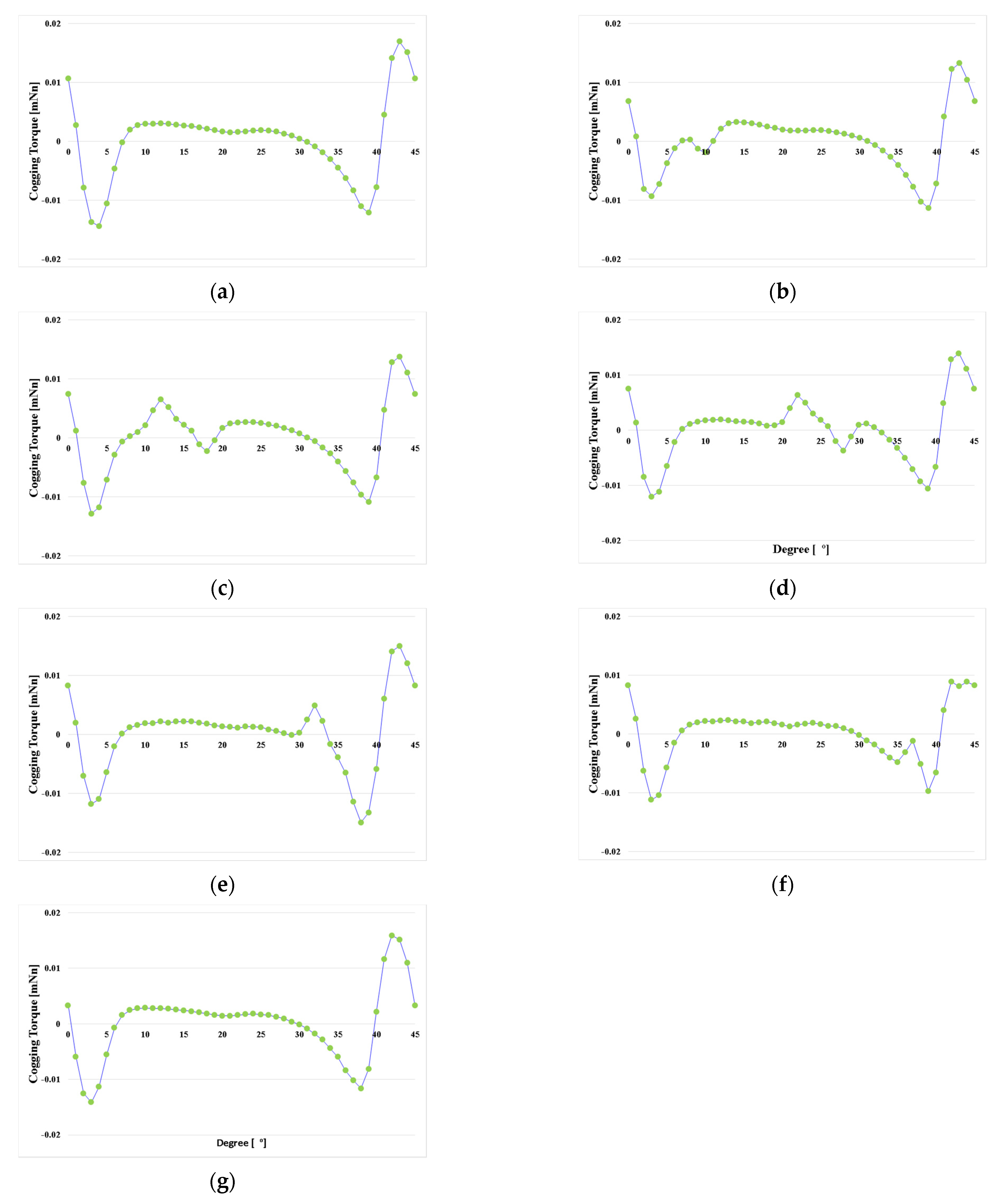

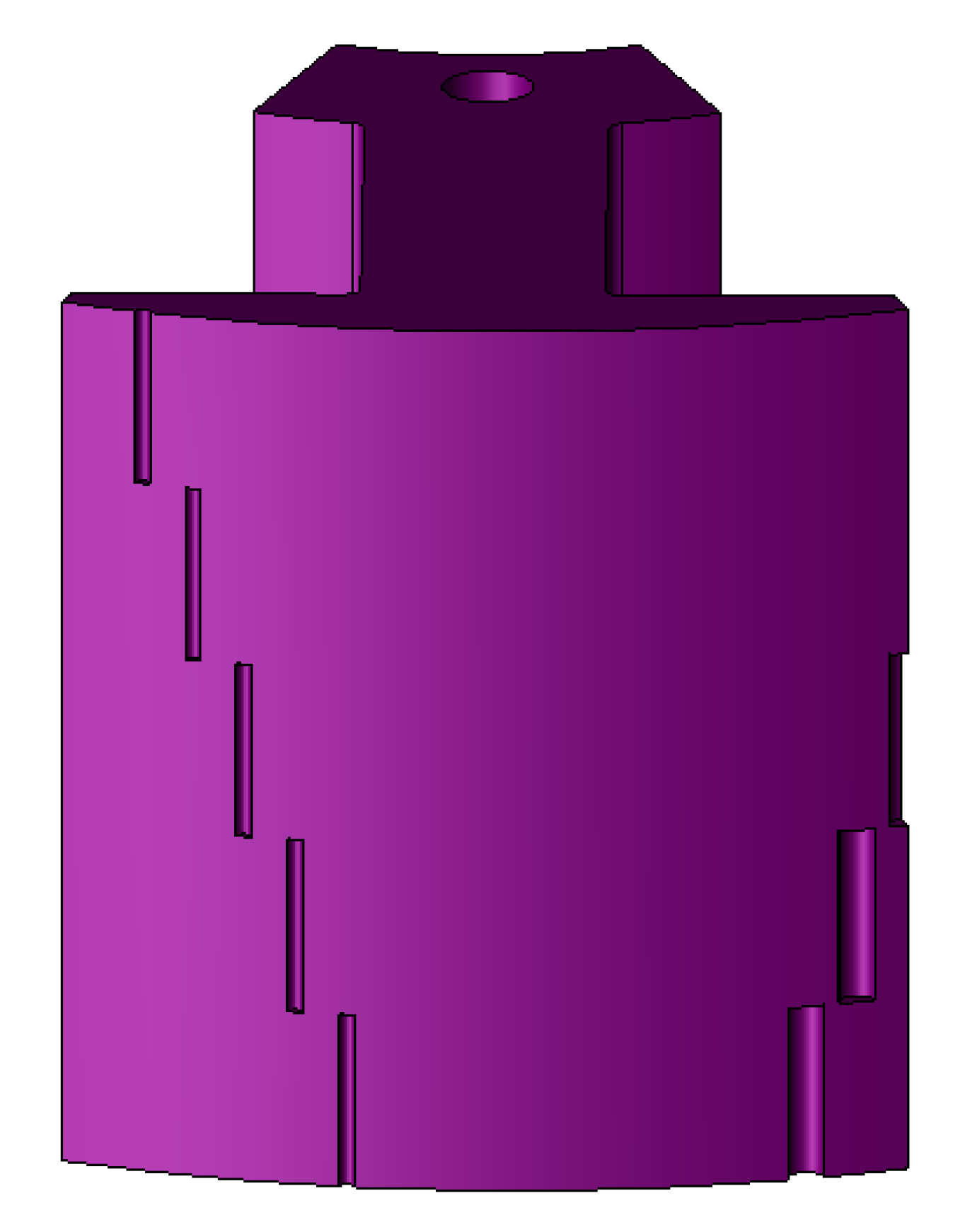
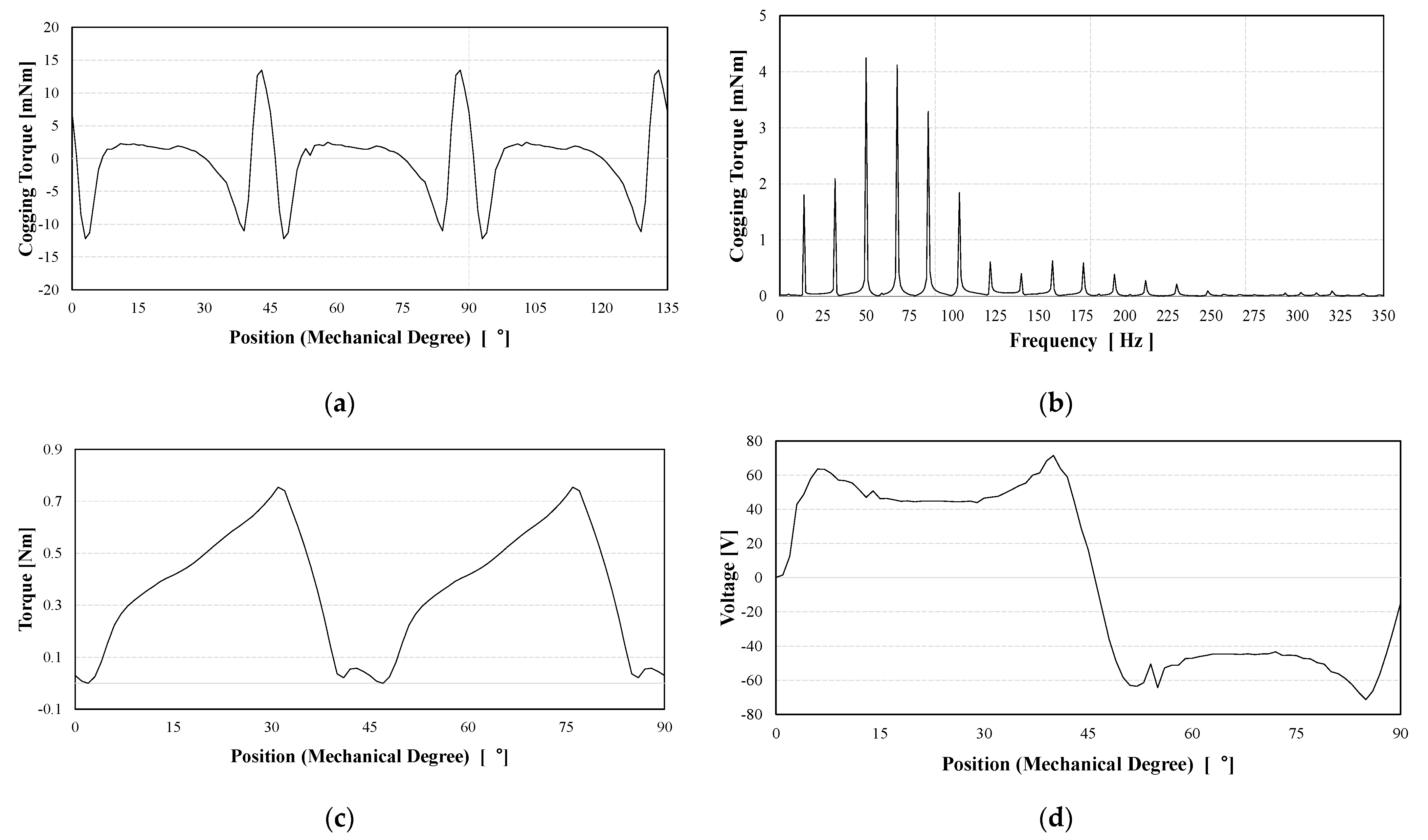
| Parameter | Unit | Value | Parameter | Unit | Value |
|---|---|---|---|---|---|
| Rated Output | W | 120 | Outside diameter | mm | 92 |
| Rated Torque | mN·m | 380 | Stack Length | mm | 30 |
| Rated Speed | Rpm | 3000 | Core Material | — | S23_0.5T |
| Input Voltage | Vac | 220 | Magnet Material | — | Ferrite (Br: 0.41~0.43 [T]) |
| Number of Slot and Poles | — | 8/8 | Winding Spec. | — |
| Cogging Torque [mN·m] | Cogging Torque [mN·m] | Cogging Torque [mN·m] | ||||||
|---|---|---|---|---|---|---|---|---|
| Notch Degree [°] | 2 | 31.35 | Notch Degree [°] | 16 | 26.41 | Notch Degree [°] | 30 | 26.38 |
| 3 | 31.55 | 17 | 26.43 | 31 | 26.61 | |||
| 4 | 25.74 | 18 | 30.06 | 32 | 26.49 | |||
| 5 | 24.89 | 19 | 26.49 | 33 | 26.58 | |||
| 6 | 24.71 | 20 | 26.27 | 34 | 27.64 | |||
| 7 | 24.68 | 21 | 26.11 | 35 | 29.96 | |||
| 8 | 25.06 | 22 | 26.01 | 36 | 31.34 | |||
| 9 | 26.14 | 23 | 25.9 | 37 | 30.04 | |||
| 10 | 26.47 | 24 | 25.95 | 38 | 26.34 | |||
| 11 | 26.53 | 25 | 25.97 | 39 | 23.24 | |||
| 12 | 26.42 | 26 | 26.67 | 40 | 20.10 | |||
| 13 | 26.45 | 27 | 26.31 | 41 | 23.84 | |||
| 14 | 26.46 | 28 | 30.09 | 42 | 28.4 | |||
| 15 | 26.62 | 29 | 26.36 | 43 | 30.05 | |||
| No. | Sampling Extracted Using OA-5Lv | Finite Element Analysis about Results for Sampling | ||||||||
|---|---|---|---|---|---|---|---|---|---|---|
| X1 | X2 | X3 | X4 | X5 | X6 | X7 | Cogging Torque | Efficiency | Torque | |
| #1 | 2 | 0.25 | 2 | 0.25 | −10 | −10 | 1 | 25.90 | 76.38 | 453.03 |
| #2 | 2 | 0.25 | 2 | 1.5 | −10 | 0 | 3 | 40.17 | 77.78 | 449.52 |
| #3 | 2 | 0.25 | 2 | 1.5 | 10 | 0 | 5 | 40.11 | 77.78 | 449.60 |
| #4 | 2 | 0.25 | 11 | 0.25 | 0 | 10 | 7 | 26.61 | 76.40 | 452.58 |
| #5 | 2 | 0.25 | 11 | 1.5 | 0 | −10 | 9 | 24.69 | 76.15 | 451.54 |
| #6 | 2 | 0.25 | 20 | 0.25 | −10 | 10 | 11 | 25.88 | 73.48 | 377.17 |
| #7 | 2 | 0.25 | 20 | 0.875 | 0 | 0 | 13 | 27.19 | 73.46 | 376.67 |
| #8 | 2 | 0.875 | 2 | 0.875 | −10 | −10 | 1 | 24.56 | 73.71 | 377.21 |
| #9 | 2 | 0.875 | 2 | 0.875 | 10 | 10 | 3 | 27.63 | 73.73 | 377.42 |
| #10 | 2 | 0.875 | 11 | 0.25 | 10 | 0 | 5 | 25.62 | 73.57 | 377.84 |
| #11 | 2 | 0.875 | 11 | 0.875 | −10 | 0 | 7 | 25.68 | 73.35 | 376.53 |
| #12 | 2 | 0.875 | 20 | 1.5 | −10 | −10 | 9 | 25.35 | 73.31 | 375.96 |
| #13 | 2 | 0.875 | 20 | 1.5 | 0 | 10 | 11 | 28.41 | 73.40 | 377.14 |
| #14 | 2 | 0.875 | 20 | 1.5 | 10 | −10 | 13 | 25.10 | 73.35 | 376.14 |
| #15 | 2 | 1.5 | 2 | 0.875 | 0 | 10 | 1 | 35.10 | 74.26 | 380.93 |
| #16 | 2 | 1.5 | 2 | 0.875 | 10 | 0 | 3 | 35.65 | 74.19 | 377.58 |
| #17 | 2 | 1.5 | 11 | 0.25 | 0 | −10 | 5 | 35.65 | 74.06 | 380.78 |
| #18 | 2 | 1.5 | 11 | 0.25 | 10 | −10 | 7 | 22.89 | 73.65 | 377.82 |
| #19 | 2 | 1.5 | 11 | 0.875 | 10 | 10 | 9 | 21.67 | 73.52 | 377.27 |
| #20 | 2 | 1.5 | 20 | 0.25 | −10 | 10 | 11 | 22.00 | 73.64 | 377.72 |
| #21 | 2 | 1.5 | 20 | 1.5 | 0 | 0 | 13 | 35.79 | 73.90 | 379.25 |
| #22 | 11 | 0.25 | 2 | 0.25 | 10 | 10 | 13 | 24.69 | 73.52 | 377.92 |
| #23 | 11 | 0.25 | 2 | 0.875 | 0 | −10 | 11 | 25.68 | 73.55 | 376.75 |
| #24 | 11 | 0.25 | 11 | 1.5 | −10 | 10 | 3 | 24.24 | 73.24 | 376.09 |
| #25 | 11 | 0.25 | 11 | 1.5 | 10 | −10 | 1 | 24.62 | 73.14 | 375.83 |
| #26 | 11 | 0.25 | 20 | 0.875 | −10 | 0 | 7 | 26.24 | 73.39 | 376.20 |
| #27 | 11 | 0.25 | 20 | 0.875 | 10 | 0 | 5 | 26.22 | 73.40 | 376.25 |
| #28 | 11 | 0.25 | 20 | 1.5 | −10 | −10 | 9 | 26.46 | 73.19 | 375.16 |
| #29 | 11 | 0.875 | 2 | 0.875 | 0 | −10 | 11 | 30.00 | 73.46 | 376.15 |
| #30 | 11 | 0.875 | 2 | 1.5 | 10 | 10 | 13 | 29.89 | 73.93 | 374.54 |
| #31 | 11 | 0.875 | 11 | 0.25 | −10 | 10 | 5 | 25.71 | 73.37 | 376.81 |
| #32 | 11 | 0.875 | 11 | 0.25 | 0 | 10 | 3 | 29.32 | 73.31 | 376.70 |
| #33 | 11 | 0.875 | 11 | 0.875 | 0 | 0 | 1 | 28.90 | 73.15 | 375.92 |
| #34 | 11 | 0.875 | 20 | 0.25 | 10 | 0 | 9 | 26.23 | 73.33 | 375.92 |
| #35 | 11 | 0.875 | 20 | 0.875 | 10 | −10 | 7 | 26.23 | 73.28 | 375.48 |
| #36 | 11 | 1.5 | 2 | 0.25 | −10 | 0 | 13 | 29.12 | 73.24 | 375.26 |
| #37 | 11 | 1.5 | 2 | 0.25 | 0 | 0 | 9 | 39.68 | 73.12 | 374.59 |
| #38 | 11 | 1.5 | 2 | 0.25 | 10 | −10 | 11 | 28.25 | 73.23 | 375.05 |
| #39 | 11 | 1.5 | 11 | 1.5 | −10 | −10 | 3 | 21.65 | 73.04 | 374.25 |
| #40 | 11 | 1.5 | 11 | 1.5 | 0 | 0 | 1 | 37.72 | 72.60 | 373.26 |
| #41 | 11 | 1.5 | 20 | 0.875 | −10 | 10 | 5 | 25.63 | 73.12 | 374.74 |
| #42 | 11 | 1.5 | 20 | 1.5 | 0 | 10 | 7 | 38.59 | 72.84 | 373.25 |
| #43 | 20 | 0.25 | 2 | 0.25 | 10 | −10 | 7 | 26.11 | 73.51 | 377.70 |
| #44 | 20 | 0.25 | 2 | 1.5 | 0 | −10 | 5 | 28.38 | 74.04 | 375.90 |
| #45 | 20 | 0.25 | 11 | 0.875 | −10 | 0 | 11 | 26.69 | 73.29 | 376.43 |
| #46 | 20 | 0.25 | 11 | 0.875 | 0 | 10 | 13 | 25.58 | 73.37 | 377.04 |
| #47 | 20 | 0.25 | 11 | 0.875 | 10 | 10 | 9 | 25.36 | 73.30 | 376.50 |
| #48 | 20 | 0.25 | 20 | 0.25 | 0 | 0 | 3 | 26.01 | 73.47 | 377.51 |
| #49 | 20 | 0.25 | 20 | 0.25 | 10 | 10 | 1 | 26.19 | 73.47 | 377.00 |
| #50 | 20 | 0.875 | 2 | 0.25 | 0 | 0 | 9 | 26.87 | 73.50 | 376.93 |
| #51 | 20 | 0.875 | 2 | 1.5 | −10 | 10 | 5 | 28.28 | 73.98 | 375.25 |
| #52 | 20 | 0.875 | 2 | 1.5 | 0 | 10 | 7 | 27.46 | 74.01 | 375.45 |
| #53 | 20 | 0.875 | 11 | 0.875 | −10 | −10 | 13 | 24.45 | 73.33 | 376.73 |
| #54 | 20 | 0.875 | 11 | 1.5 | 10 | 0 | 11 | 27.94 | 72.93 | 374.75 |
| #55 | 20 | 0.875 | 20 | 0.25 | −10 | 0 | 1 | 26.20 | 73.43 | 376.95 |
| #56 | 20 | 0.875 | 20 | 0.25 | 0 | −10 | 3 | 26.07 | 73.43 | 376.95 |
| #57 | 20 | 1.5 | 2 | 0.875 | −10 | 10 | 9 | 25.86 | 73.37 | 375.45 |
| #58 | 20 | 1.5 | 2 | 1.5 | −10 | 0 | 7 | 40.19 | 74.58 | 372.44 |
| #59 | 20 | 1.5 | 11 | 0.25 | −10 | −10 | 13 | 26.51 | 73.25 | 375.48 |
| #60 | 20 | 1.5 | 11 | 1.5 | 10 | 0 | 11 | 28.27 | 72.77 | 373.33 |
| #61 | 20 | 1.5 | 20 | 0.875 | 0 | −10 | 5 | 26.60 | 73.24 | 374.86 |
| #62 | 20 | 1.5 | 20 | 0.875 | 10 | −10 | 3 | 30.65 | 76.15 | 438.65 |
| #63 | 20 | 1.5 | 20 | 1.5 | 10 | 10 | 1 | 26.94 | 72.99 | 372.79 |
| Item | Unit | Earlier Model | 2 Notches Model | Step-Sloping Notch Model (GA Optimal) | Step-Sloping Notch Optimal Model (FEA) | |
|---|---|---|---|---|---|---|
| Design variables | X1 | [°] | 0 | 8.502 | 2 | 2 |
| X2 | [mm] | 0 | 1.314 | 1.2162 | 1.2162 | |
| X3 | [°] | 0 | 18.448 | 11.0925 | 11.0925 | |
| X4 | [mm] | 0 | 0.812 | 0.5 | 0.5 | |
| X5 | [°] | 0 | 0 | 9.999 | 10 | |
| X6 | [°] | 0 | 0 | −10 | −10 | |
| X7 | [EA] | 1 | 1 | 4.777 | 5 | |
| Results | Cogging torque | [mN·m] | 61.9 | 43.6 | 21.7 | 22.3 |
| Efficiency | [%] | 75.434 | 75.25 | 74.77 | 73.5 | |
| Torque | [mN·m] | 478.87 | 451.87 | 394.9 | 390.5 | |
Publisher’s Note: MDPI stays neutral with regard to jurisdictional claims in published maps and institutional affiliations. |
© 2021 by the authors. Licensee MDPI, Basel, Switzerland. This article is an open access article distributed under the terms and conditions of the Creative Commons Attribution (CC BY) license (https://creativecommons.org/licenses/by/4.0/).
Share and Cite
Park, Y.-w.; Ko, J.-s.; Kim, D.-k. Optimal Design of Step-Sloping Notches for Cogging Torque Minimization of Single-Phase BLDC Motors. Energies 2021, 14, 7104. https://doi.org/10.3390/en14217104
Park Y-w, Ko J-s, Kim D-k. Optimal Design of Step-Sloping Notches for Cogging Torque Minimization of Single-Phase BLDC Motors. Energies. 2021; 14(21):7104. https://doi.org/10.3390/en14217104
Chicago/Turabian StylePark, Yong-woon, Jae-sub Ko, and Dae-kyong Kim. 2021. "Optimal Design of Step-Sloping Notches for Cogging Torque Minimization of Single-Phase BLDC Motors" Energies 14, no. 21: 7104. https://doi.org/10.3390/en14217104






